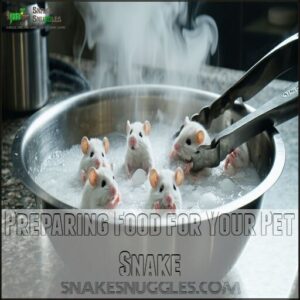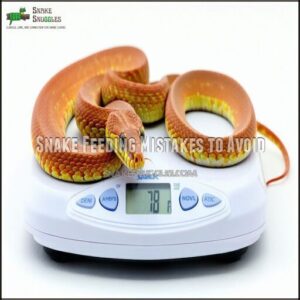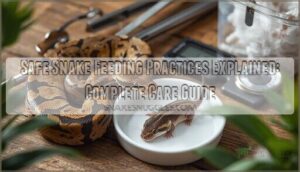This site is supported by our readers. We may earn a commission, at no cost to you, if you purchase through links.

A good rule of thumb is to offer prey about the same size as the thickest part of your snake’s body.
Baby snakes eat more often—every 5–7 days—while adults need feeding only every 7–14 days, depending on the species.
Always use high-quality, thawed frozen prey (or live, if that’s your snake’s preference), and avoid overfeeding, which can lead to obesity.
Pay attention to your snake’s behavior—they’ll let you know if they’re still hungry.
Remember, a well-fed snake is a content snake, and a lot less grumpy! Curious about portion tips? Keep reading!
Table Of Contents
- Key Takeaways
- Choosing The Right Snake Food
- Factors Affecting Snake Feeding Frequency
- Preparing Food for Your Pet Snake
- Feeding Frequency for Different Snake Species
- Snake Feeding Habits and Behaviors
- The Dangers of Overfeeding Your Snake
- Supplements and Vitamins for Your Pet Snake
- Providing Fresh Water for Your Snake
- Snake Feeding Mistakes to Avoid
- Monitoring and Adjusting Your Snake’s Feeding Schedule
- Frequently Asked Questions (FAQs)
- How often should you feed a snake as a pet?
- How much should a snake eat a week?
- How much food can a pet snake eat?
- How often should a baby snake eat?
- How do you feed a snake?
- Do snakes need a lot of food?
- How much should you feed a snake?
- How can I tell if my snake is hungry?
- Can you feed a snake everyday?
- How to properly feed your snake?
- Conclusion
Key Takeaways
- Match the prey size to your snake’s thickest part, about 1-1.5 times its width, to ensure proper digestion and prevent regurgitation.
- Feed juvenile snakes every 5–7 days, while adults typically eat every 7–14 days, depending on their species, size, and activity level.
- Thaw frozen prey thoroughly in warm water and use feeding tongs to mimic natural movement, avoiding live prey to prevent injuries.
- Watch for hunger cues like increased movement or tongue flicking, and adjust feeding schedules based on your snake’s age, size, and behavior.
Choosing The Right Snake Food
You’ll need to match your snake’s natural diet by selecting prey that’s about 1-1.5 times the width of your snake’s midsection.
The right food choice isn’t just about size though—it’s about offering quality, properly prepared prey that meets your particular snake’s dietary needs.
Just like how you wouldn’t feed a salad to your cat or a steak to your goldfish.
Importance of Prey Size
The perfect prey size forms the cornerstone of proper snake nutrition.
Aim for food that’s about 1-1.5 times your snake’s widest body section, creating a visible but not excessive bulge after feeding.
This prey-weight ratio guarantees ideal digestion time while preventing regurgitation.
As your snake grows, follow a size progression with their meals—smaller snakes need smaller prey.
Never exceed 10% of your snake’s body weight when offering multiple feeders, ensuring a proper and safe feeding practice.
Prey Types for Different Snake Species
Now that we’ve covered proper prey sizing, let’s match the right food to your snake’s species.
Different snakes have evolved to hunt specific prey in the wild. Your pet’s diet should reflect these natural preferences:
- Corn snakes: Primarily eat rodents, but can occasionally enjoy quail eggs or small lizards
- Ball pythons: Thrive on appropriately sized mice and rats
- Garter snakes: Prefer insects, earthworms, and small fish
- King cobras: Uniquely feed on other snakes in the wild.
Your snake’s size also influences prey selection. Small species might stick with insects, while larger ones like pythons can graduate to bigger meals.
Many owners find specialized snake food convenient for their pets. When in doubt, research your specific snake’s natural diet for the best results.
Feeding Live Vs. Frozen Prey
Once you’ve matched prey types to your snake’s species, let’s tackle the live vs. frozen debate.
While live prey stimulates your snake’s hunting instinct, it poses significant risks—rodents can injure your pet and transmit diseases.
Frozen prey offers safety and convenience with minimal nutrition loss. Plus, it’s more ethical and often cheaper long-term.
Your choice should prioritize your snake’s safety while respecting their natural feeding behaviors.
Prey Quality and Freshness
While frozen prey is convenient, quality matters just as much as method. Your snake’s health depends on freshness and nutritional value of each meal.
- Store frozen mice in airtight containers to prevent freezer burn
- Thaw frozen-thawed prey in sealed bags in warm water, never microwave
- Check for discoloration or unusual odors before feeding
- Practice gut loading (feeding prey nutritious foods before freezing)
- Rotate prey types occasionally to mimic varied species diets
Proper prey storage extends shelf life while maintaining nutrients. When thawing methods preserve freshness, your snake gets maximum benefit from each meal. Remember that prey size should match your snake’s girth—about 1-1.5 times their widest body point. Quality feeding equals a thriving pet!
Factors Affecting Snake Feeding Frequency
You’ll need to adjust your snake’s feeding schedule based on its age, size, and how active it is, just like how teenagers seem to eat everything in sight while grandpa nibbles on a single cookie.
Your snake’s environment, including temperature and seasonal changes, will also affect how often it needs to eat, so watch for hunger cues like increased movement or tongue flicking.
Snake Age and Feeding Frequency
Every snake’s age dramatically impacts their feeding frequency, creating distinct nutritional needs at different life stages.
Baby snakes need meals twice weekly to fuel their rapid growth spurts. These tiny juveniles have lightning-fast metabolisms that require frequent feeding.
As snakes mature, their dietary shifts become apparent. Adult snakes typically eat every 7-14 days, conserving energy between meals.
During brumation (snake hibernation), adults may skip feeding entirely for weeks or months.
Track your snake’s development carefully—what worked for your juvenile won’t match adult schedules. Adjust accordingly to support healthy growth throughout your pet’s life, considering their distinct nutritional needs and dietary shifts.
Snake Size and Feeding Frequency
While your snake’s age matters, size plays an equally important role in determining feeding frequency.
Your snake’s body mass directly affects its metabolism and nutritional needs.
- Small juveniles (under 200g): Feed twice weekly with appropriately sized prey
- Medium snakes (200-800g): Weekly meals maintain healthy growth
- Large snakes (800g+): Every 10-14 days prevents overfeeding
- Female breeding snakes: More frequent meals support egg development
Remember, a proper feeding schedule prevents obesity and supports your snake’s natural digestive rhythm.
Snake Activity Level and Feeding Frequency
Your snake’s activity level directly impacts how often it needs to eat.
Just like humans, active snakes burn more energy and require more frequent feeding to maintain their health and well-being.
| Activity Level | Feeding Frequency | Metabolism Impact |
|---|---|---|
| Very Active | Every 5-7 days | High energy burn |
| Moderate | Every 7-10 days | Balanced needs |
| Sedentary | Every 10-14 days | Slower digestion |
| Brumating | Monthly or less | Minimal needs |
| Shedding | Pause until done | Temporary slow |
During shedding cycles, many snakes naturally decrease their activity and feeding frequency. Active snakes burn more energy and require more frequent feeding to maintain their health and well-being.
Environmental Factors and Feeding Frequency
The environment inside your snake’s home directly impacts its appetite.
Temperature effects are particularly vital—warmer conditions boost metabolism, increasing feeding frequency, while cooler temperatures slow digestion.
Proper humidity levels guarantee healthy shedding cycles, which affect when your snake will eat.
Seasonal changes naturally alter feeding patterns, with most snakes eating more in spring and summer.
During brumation periods (winter hibernation), feeding may stop entirely.
Enclosure size matters too—cramped quarters create stress that reduces appetite.
For ideal snake feeding schedules, match your environmental setup to your snake’s natural habitat, adjusting temperature and humidity seasonally, considering temperature effects, proper humidity levels, and seasonal changes to ensure a healthy and thriving pet, with a suitable enclosure size.
Preparing Food for Your Pet Snake
You’ll need to prepare your snake’s food properly to guarantee they’re getting the nutrition they need.
Without the risks that come with improper handling, thawing frozen prey completely and warming it to the right temperature will make the difference between a happy, well-fed snake and one that might turn its nose up at dinner time, which is why proper handling is crucial for a happy snake.
Thawing Frozen Prey
The proper thawing of frozen prey is essential for your snake’s health and feeding response. Never use a microwave or hot water, as these methods can cook portions unevenly.
Thaw prey slowly in warm water, not a microwave, to ensure safe, even temps for your snake’s meal.
Follow these safe thawing steps:
- Place frozen feeders in a sealed bag in cold water for gradual thawing (water displacement method)
- Allow small prey 1-2 hours to thaw; larger items may need 3-4 hours
- Warm to room temperature before offering to mimic a live prey’s body heat
Never refreeze thawed prey, as this increases bacterial contamination risk. For ideal thawing, consider using specialized snake thawing products. Properly thawed food encourages your snake’s natural feeding instincts and prevents digestive issues, ensuring a healthy feeding response with proper thawing.
Feeding Prey Whole
Now that you’ve properly thawed your snake’s meal, it’s time to offer whole prey. This natural feeding method provides complete nutrition while satisfying your pet’s instinctive hunting behavior.
| Benefits of Whole Prey | Why It Matters |
|---|---|
| Complete nutrition | Provides all vitamins and minerals |
| Natural digestion | Matches snake’s digestive system |
| Portion control | Right size prevents health issues |
| Mental stimulation | Triggers natural feeding response |
| Ethical feeding | Respects snake’s biological needs |
Always match prey size to your snake’s girth—about 1-1.5 times their midsection. Whole prey nutrition is essential for your snake’s health, and you can learn more at Whole prey nutrition. Your scaly friend will thank you for respecting their biological needs and providing natural feeding methods.
Prey Presentation and Feeding Techniques
Five simple techniques can transform your snake’s mealtime from ordinary to engaging. When presenting prey to your pet, always use feeding tongs instead of your hands to prevent scent transfer and accidental bites.
The right prey presentation mimics your snake’s natural hunting experience. Most species respond well to gentle movement – try wiggling frozen-thawed prey to trigger their predatory instincts.
Here’s how to perfect your feeding techniques:
- Watch for hunger cues like increased activity or tongue flicking
- Warm prey thoroughly to body temperature before offering
- Use a separate feeding container for snakes that associate hands with food
- Time feedings according to your snake’s established feeding schedule
Remember, your goal isn’t just nutrition, but also stimulating natural behaviors. A properly presented meal keeps your snake physically and mentally healthy.
Feeding Frequency for Different Snake Species
You’ll need to adjust your feeding schedule based on your snake’s species, just as you wouldn’t expect a Chihuahua and a Great Dane to eat the same amount.
From corn snakes needing meals every 5-7 days when young to Burmese pythons eating just once every few weeks, understanding your specific reptile’s natural feeding rhythm is key to keeping them healthy.
Feeding Frequency for Young Snakes
Nearly all young snakes experience rapid growth spurts, requiring more frequent feeding than their adult counterparts.
The feeding schedule for snakes varies by age, with different requirements for hatchlings, babies, juveniles, subadults, and young adults.
| Snake Age | Feeding Frequency | Meal Size | Notes | Indicators |
|---|---|---|---|---|
| Hatchlings | Every 5-7 days | Snake’s girth | Most vulnerable stage | Active hunting behavior |
| Babies | Every 7-10 days | Equal to girth | Until 2 years old | Increased shedding frequency |
| Juveniles | Every 8-9 days | Slightly larger | Growth is priority | Regular weight gain |
| Subadults | Every 10-12 days | 10-15% body weight | Brumation impact begins | Less aggressive feeding |
| Young adults | Weekly | Proper sized prey | Developmental period | Consistent growth |
Feeding Frequency for Adult Snakes
While mature snakes have slowed their growth, adult snakes typically eat every 7-14 days depending on their species and size.
Larger species like rat snakes may wait up to two weeks between meals, while active tree snakes require weekly feeding. Common options include frozen-thawed mice.
Your feeding schedule should adjust for:
- Species differences – Psammophis need more frequent meals than ball pythons
- Brumation impact – Expect feeding refusals during winter dormancy periods
- Shedding cycle – Many snakes refuse food when approaching a shed
Monitor your snake’s body condition to fine-tune their feeding frequency.
Feeding Frequency for Pregnant or Breeding Snakes
When breeding season approaches, you’ll need to adjust your snake feeding schedule.
Female snakes require extra nutrition during gestation feeding to support egg production. Offer them meals every 14-21 days, with occasional "snacks" between regular feedings.
Breeding females need this additional sustenance to maintain health while developing eggs. Males maintain their regular feeding frequency during this time.
Monitor your snake’s appetite closely and make feeding adjustments based on their individual needs and weight, as well as their overall health to ensure a successful breeding season with proper egg production and a healthy snake.
Snake Feeding Habits and Behaviors
You’ll notice your snake sending clear signals when it’s hungry, from increased movement to tongue flicking that says "dinner time" as clearly as a ringing dinner bell.
Learning to read these feeding cues isn’t just fascinating—it’s essential for keeping your scaly friend healthy and avoiding the common pitfalls of overfeeding or underfeeding, which can be prevented by recognizing these signals as a clear indication of "dinner time".
Understanding Your Snake’s Feeding Behavior
After establishing a feeding schedule for your snake species, it’s time to learn their unique feeding behavior.
Different snakes show different hunger cues, from active tongue flicking to increased enclosure exploration. Your snake’s body language tells a story – watch for alert, coiled postures that signal readiness to eat.
- Snake feeding response varies dramatically between individuals; what works for one mightn’t work for another.
Pay attention when your snake refuses food, as this could indicate stress, illness, or simply brumation effects during cooler months.
Some snakes are naturally fussy eaters requiring feeding isolation to reduce distractions.
If your snake regurgitates, wait 10-14 days before offering food again.
Remember that snake appetite fluctuates with seasons and life stages. By observing your snake’s feeding habits consistently, you’ll develop intuition about when they’re hungry – like knowing when your dog wants a walk!
Recognizing Hunger and Fullness Cues
Recognizing your snake’s hunger and fullness cues requires attentive observation of their unique behaviors. Watch for activity increase—restless movement and increased tongue flicking often signal it’s mealtime.
Restless movement and constant tongue flicking mean one thing: your snake is hungry and ready for its next meal.
Your snake’s feeding response intensifies when hungry, showing heightened interest in warm objects or movement. Monitor weight consistently, as subtle changes can indicate whether your pet needs more or less food.
During shedding, expect reduced appetite, which is completely normal. Be alert for regurgitation signs, which suggest overfeeding.
Brumation effects also impact feeding schedules seasonally. Understanding snake feeding habits is essential for proper care.
By learning these snake feeding behaviors, you’ll develop an intuitive understanding of your pet’s appetite patterns—much like learning their personal language, which requires heightened awareness and consistent monitoring.
The Dangers of Overfeeding Your Snake
You’ll quickly turn your slithery friend into a sluggish paperweight if you consistently offer more food than needed.
Just like that friend who can’t stop ordering dessert, an overfed snake faces serious health issues including obesity, metabolic disorders, and a substantially shortened lifespan.
Risks of Obesity in Snakes
Now that you’ve observed your snake’s eating behaviors, let’s talk about what happens when they get too much of a good thing.
Just like humans, snakes can become overweight, leading to serious health issues.
Here are five risks of snake obesity:
- Metabolic disorders affecting organ function
- Reduced lifespan by several years
- Decreased activity and mobility
- Reproductive complications
- Increased stress on internal organs
Weight management is essential for your snake’s health. Proper feeding schedules and encouraging natural movement will help keep your scaly friend fit and thriving.
Signs and Symptoms of Overfeeding
Warning signs of overfeeding your snake lurk beneath those beautiful scales.
Watch for weight gain and skin folds around the mid-section, which signal a snake that’s consuming too much prey.
Lethargy and decreased activity follow as your reptile struggles with digestion, and some snakes even regurgitate meals when consistently overfed.
During handling, an overweight snake feels heavy with soft tissue beneath its scales, which is a clear indicator of overweight issues, affecting peak snake health.
Regular monitoring prevents snake obesity and maintains peak snake health.
Prevention and Management of Overfeeding
In light of preventing snake obesity, your vigilance matters most.
Start by tracking weight monthly—a digital kitchen scale works perfectly for this purpose.
Establish strict schedules based on your snake’s species, age, and size, avoiding the temptation to feed "just one more mouse."
Recognize obesity signs early: fat rolls along the spine, difficulty moving, or labored breathing indicate overfeeding.
If you spot these warning signals, immediately reduce feeding frequency—not portion size.
Increase your pet’s activity through enrichment and larger enclosures.
Adding diet variety keeps feeding interesting without adding calories.
Remember: it’s easier to prevent overfeeding than to help your snake lose weight later.
Regular weighing remains your best tool against snake health problems, and maintaining a healthy weight is crucial for your pet’s well-being.
Supplements and Vitamins for Your Pet Snake
You’ll need to supplement your snake’s diet with calcium and vitamin D3 to keep their bones strong and immune system healthy, just like humans need their daily vitamins.
While whole prey animals provide most nutrients your snake needs, adding the right supplements can help prevent health issues that might leave your scaly friend feeling less than fabulous.
Importance of Calcium and Vitamin D3
Calcium and Vitamin D3 work hand in hand for your snake’s overall health.
Without these nutrients, your reptile friend might face serious health challenges.
- Calcium supports proper bone development and prevents metabolic bone disease
- Vitamin D3 helps absorb calcium and promotes eggshell strength in breeding females
- UVB lighting mimics natural sunlight, helping snakes produce their own D3
- Supplement dosing must be precise—overdosing can be as harmful as deficiencies
- Regular supplementation strengthens immune function and prevents disorders
Most captive snakes get calcium and D3 from whole prey items like mice, which contain bones and organs.
However, prey raised in captivity may lack ideal nutrient levels, making targeted supplementation necessary for your snake’s long-term health.
Types of Supplements for Snakes
Beyond proper feeding, your pet snake may need specific supplements to thrive.
Calcium supplements support strong bone development, especially when paired with vitamin D3 for proper absorption.
Many snake owners use multivitamins in powder or liquid form to prevent nutritional gaps in their pet’s diet.
For insect-eating species, consider gut-loading products like Repashy Superload that enhance feeder insects’ nutritional value.
Preformed vitamin A supplements are particularly important for non-herbivorous snakes to maintain vision and skin health.
Some reptile keepers also use mineral blocks or specialized probiotics formulated for reptiles to support digestion and overall snake health.
You can find a snake calcium supplement online.
Remember, each species has unique nutritional needs requiring different supplementation approaches, and it is crucial to provide the right supplements for your pet snake to thrive.
Administering Supplements Safely and Effectively
Now that you understand supplement types, let’s talk application. Properly administering supplements to your snake is like adding seasoning to food—it’s all about balance.
Here’s how to do it right:
- Mix with food: Dust prey items with calcium or vitamin D3 supplements right before feeding
- Follow the schedule: Most snakes need calcium weekly and vitamin D3 bi-weekly
- Watch for signs: Monitor for unusual behavior that might indicate over-supplementation
Always consult your vet for personalized guidance.
Providing Fresh Water for Your Snake
You’ll need to provide fresh, clean water for your snake daily, just as essential as offering the right-sized prey.
While your scaly friend won’t thank you with a wet kiss, proper hydration supports healthy digestion, successful shedding, and overall well-being.
Water Quality and Freshness
While supplements support your snake’s diet, proper water quality is equally essential for overall health.
Fresh, clean water must be available daily for your pet snake.
| Water Source | Benefits | Considerations |
|---|---|---|
| Tap water | Convenient, inexpensive | Requires dechlorination |
| Filtered water | Removes contaminants | Regular filter changes needed |
| Bottled water | Ready-to-use | More expensive option |
| Distilled water | Free of minerals | May lack beneficial minerals |
| Rainwater | Natural option | Requires proper collection and storage |
Change water every 1-2 days and clean bowls weekly to prevent bacterial growth.
Water Bowls and Hydration Systems
Keeping your snake hydrated starts with the right water bowl! Choose a sturdy, non-tip ceramic option that matches your snake’s size—big enough to drink from, but not so large it becomes a pool.
Freshwater matters for health and humidity levels, so swap it daily. Here’s how to up your snake hydration game:
- Use non-spill bowls.
- Change water daily for top water quality.
- Avoid plastic; it absorbs odors.
- Monitor for dehydration signs.
By following these steps, you can ensure your snake stays healthy and hydrated.
Monitoring and Maintaining Proper Humidity
Humidity plays a big role in keeping your snake happy and healthy. It affects shedding, hydration levels, and even respiratory health!
Check your enclosure setup often to confirm proper humidity monitoring.
Here’s how to keep things balanced:
- Use moisture-retaining substrate, like coconut fiber or sphagnum moss.
- Add a shallow water dish for snake hydration and extra humidity.
- Try misting systems or hand-misting daily to maintain ideal levels.
A healthy habitat means fewer shedding issues and a content snake!
Snake Feeding Mistakes to Avoid
Feeding your snake may seem simple, but common mistakes can lead to health problems or stress.
By avoiding errors like overfeeding, underfeeding, or using poor-quality prey, you can keep your snake happy and thriving.
Inadequate Feeding Frequency
Not feeding your snake often enough can lead to serious trouble. Young snakes, which are like little growth machines, need frequent meals to avoid growth stunting.
Miss too many feedings, and you might see behavioral changes, snake weight loss, weakened immunity, or even organ damage. Think of it this way—skipping meals for them is like trying to run a car on an empty tank.
Age, size, and activity levels are your guides. Juveniles are active and growing, so they need weekly feeds or more.
For adults, feeding frequency depends on species and weight. Also, watch for brumation effects, when snakes naturally eat less.
Keep meal timing consistent and adjust the snake feeding amount to match its current needs. When in doubt, observe closely!
Poor Prey Quality and Presentation
Your snake’s dinner shouldn’t come with a side of bacterial contamination. Poor thawing methods or old frozen-thawed prey can result in prey rejection or worse, nutritional deficiency.
Always match prey size to your snake’s body width, and keep prey types consistent with their natural diet.
To avoid issues, be sure to take into account adequate feeding frequency.
Scent masking tricks might help finicky eaters, but quality matters most. Handle prey carefully to maintain snake feeding quality—it’s a small effort for better snake nutrition and happier pets!
Overfeeding and Underfeeding
Striking the right balance when feeding your snake is critical to avoid health problems.
Overfeeding can lead to obesity risks, while underfeeding might cause weight loss and malnutrition. Watch for feeding signs—they’ll tell you if adjustments are needed.
Here’s how to avoid issues:
- Stick to species-specific feeding schedules.
- Weigh your snake regularly to monitor health.
- Adjust portions during brumation or activity changes.
- Observe behaviors like restlessness or lethargy for feeding cues.
A healthy diet keeps your snake thriving!
Monitoring and Adjusting Your Snake’s Feeding Schedule
Keeping track of your snake’s feeding schedule is key to ensuring its health and happiness.
If your pet starts skipping meals or growing too fast, it’s time to adjust and find the right balance.
Tracking Feeding Frequency and Amount
To keep your snake happy and healthy, tracking feeding frequency is a must.
Jot down feeding logs, monitor snake weight, and tweak meal sizes if needed. Spot patterns like sudden refusal reasons or overfeeding signs to adjust quickly.
Use a growth tracking table like this:
| Log Date | Prey Size | Snake Weight |
|---|---|---|
| March 5 | Medium Mouse | 500g |
| March 12 | Large Mouse | 510g |
| March 19 | Medium Rat | 525g |
Stay proactive, and watch your snake thrive!
Adjusting Feeding Schedules Based on Snake Age and Size
As your snake grows, so should its feeding plan. Growth spurts, brumation impact, and size variation all affect its dietary needs.
Juvenile schedules often demand more frequent meals, while feeding adult snakes focuses on spaced-out, larger portions.
Adjusting the snake feeding schedule is simple:
- Watch your snake’s weight for feeding frequency clues.
- Tailor meals for snake age and size.
Larger snakes need fewer, bigger meals. Juveniles thrive on smaller, frequent feedings.
Individual behavior can guide changes naturally.
Monitoring Snake Health and Adjusting Feeding Accordingly
Watching your snake’s health means checking its weight regularly—stable numbers often mean things are on track.
Look for smooth shedding; patchy skin might hint at trouble. Lethargy or sudden eating changes? Those could signal illness.
Don’t ignore regurgitation signs or odd-looking feces. Keep an eye on body condition—soft bellies or folds suggest underfeeding or overfeeding.
If your snake’s in brumation, expect reduced appetite but verify hydration. When in doubt, a vet visit never hurts!
Frequently Asked Questions (FAQs)
How often should you feed a snake as a pet?
Feed juvenile snakes twice a week, while adults usually eat every 7-14 days depending on their size and species.
Watch for hunger cues like increased activity, but don’t overdo it—nobody wants a hangry snake!
How much should a snake eat a week?
It depends on your snake’s size and species.
Offer prey about 10% of their body weight weekly.
Smaller snakes eat more often, while larger ones may need meals every two weeks.
Balance is key!
How much food can a pet snake eat?
Imagine your snake as a picky diner. Offer prey matching its girth, about 10% of its body weight. Feed weekly or bi-weekly, adjusting portions for age, size, and activity.
How often should a baby snake eat?
Baby snakes need to eat twice a week to support their rapid growth.
Stick to appropriately sized prey, about 10% of their body weight.
It’s like feeding a tiny, scaly teenager with endless energy!
How do you feed a snake?
Offer thawed, body-warm prey with feeding tongs, mimicking natural movements to spark your snake’s hunting instincts.
Feed in their enclosure, never by hand, to avoid association.
Stick to their feeding schedule, and monitor digestion closely.
Do snakes need a lot of food?
Snakes don’t need a ton of food.
They’re the ultimate slow eaters, often dining just once a week or less.
Feed them based on size, age, and species to keep them healthy and happy!
How much should you feed a snake?
It’s funny how even snakes have portion control.
Feed prey about 10-15% of your snake’s body weight.
Stick to 1-5 times its widest point size-wise, ensuring digestion stays smooth and safe.
How can I tell if my snake is hungry?
Your snake might be hungry if it becomes more active, prowling around or tongue-flicking frequently.
You’ll also notice it focusing on movements near its enclosure.
Think of it as a reptile’s way of saying, “What’s for dinner?” when it exhibits these behaviors, indicating it is hungry.
Can you feed a snake everyday?
Feeding a snake daily isn’t necessary and can harm its health.
Most species thrive with meals every 7–14 days, depending on age, size, and activity.
Overfeeding risks obesity—don’t overstuff your scaly buddy!
How to properly feed your snake?
Offer appropriately sized prey, about 10% of the snake’s weight, every 7–14 days for adults.
Use feeding tongs, thaw prey fully, and avoid live feeding to prevent injuries, and feed juveniles twice a week.
Conclusion
Worried about over- or underfeeding your snake? Don’t be—it’s simpler than you think.
By offering prey that matches the thickest part of your snake’s body and sticking to the right schedule, you’ll keep your pet healthy and happy.
Remember, baby snakes eat more often, while adults need less frequent meals.
Watch for hunger cues, avoid overfeeding, and always use high-quality prey.
With a little attention, you’ll master how much to feed a snake in no time!






















